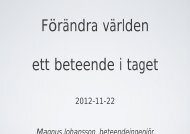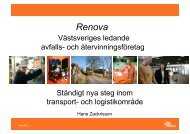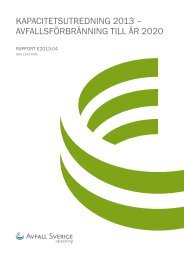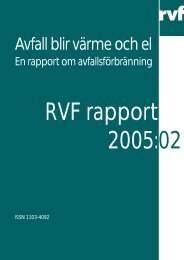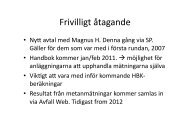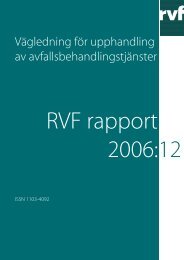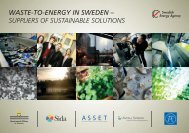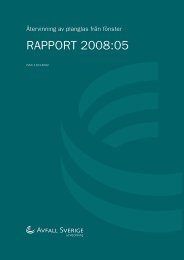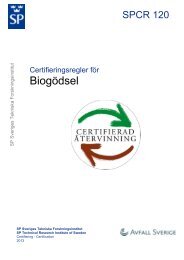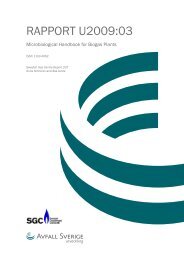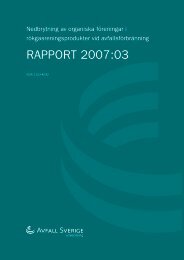SwediSh waSte management |2011 - Avfall Sverige
SwediSh waSte management |2011 - Avfall Sverige
SwediSh waSte management |2011 - Avfall Sverige
You also want an ePaper? Increase the reach of your titles
YUMPU automatically turns print PDFs into web optimized ePapers that Google loves.
Swedish waste <strong>management</strong> 2011LandfillIn 2010, 42,000 tons of household wastewent to landfills. This is a reduction of 21,000tons, or 33 percent, compared with 2009.Divided over the population, it represents 4.5kg per person. It also means that 1.0 percentof household waste was landfilled. In 2010, atotal of 1,271,000 tons of waste was depositedat the Swedish landfills for municipal waste,an increase of 240,000 tons compared with2009.Landfilling is the treatment method that isused for waste which cannot be treated otherwise,for instance tiles, porcelain ware andcrushed concrete.In 1994, <strong>Avfall</strong> <strong>Sverige</strong> – Swedish WasteManagement started to collect statistics onhousehold waste deposited to landfills. Sincethen, the amount of landfilled waste hasdecreased by 97 percent.At modern landfill sites, waste disposal isonly part of the business conducted. Mostsites also attend to separation of waste materialsgoing to treatment, to transport on torecovery and recycling, and to energy recovery.Sometimes landfill sites also serve astemporary storage of large quantities of wastethat fall under the producer’s responsibility,such as paper, glass and waste fuel.Plants also often treat biodegradable wasteand contaminated soil.Final capping of closed landfills and landfillcells can also take a long time. On December31, 2008, much stricter EU regulations regardinglandfilling took effect, and almost half of alllandfill sites for municipal waste were closed.In 2010 household waste was landfilled at 76waste <strong>management</strong> plants. Most of theselandfill sites take non-hazardous waste.Landfills that are closed must be capped witha final cover. Together these landfills cover anestimated area of 25km2, and the estimatedtotal cost for final covering of the sites is aboutSEK 6 billion. Every year, approximately 6-8million tons of material is used for the finalcovers of landfill sites. Natural material is notalways available, and in many cases, residues,such as contaminated soil, ashes, sludge etc.,is used instead.In 2010, approximately 300 GWh was producedfrom recovered landfill gas at 57 waste<strong>management</strong> plants, of which 262 GWh wasused for energy. Energy recovery consisted of20 GWh as electricity and 242 GWh as heat. Inall, 37 GWh of landfill gas was flared. Energy isnot produced from flaring, but methane emissionsare reduced. Waste is still disposed tolandfills at 40 plants.In 2010, waste <strong>management</strong> plants thatlandfill waste treated almost 6 million cubicmeters leachate, including polluted surfacewater from storage, separation and treatmentareas. Dilution due to leakage of groundwaterand surface water can also vary significantlyat the different plants. More than 40 percentof plants state that leachate is diverted tomunicipal wastewater plants after variousdegrees of local treatment. Other plants statethat leachate is treated locally.24



